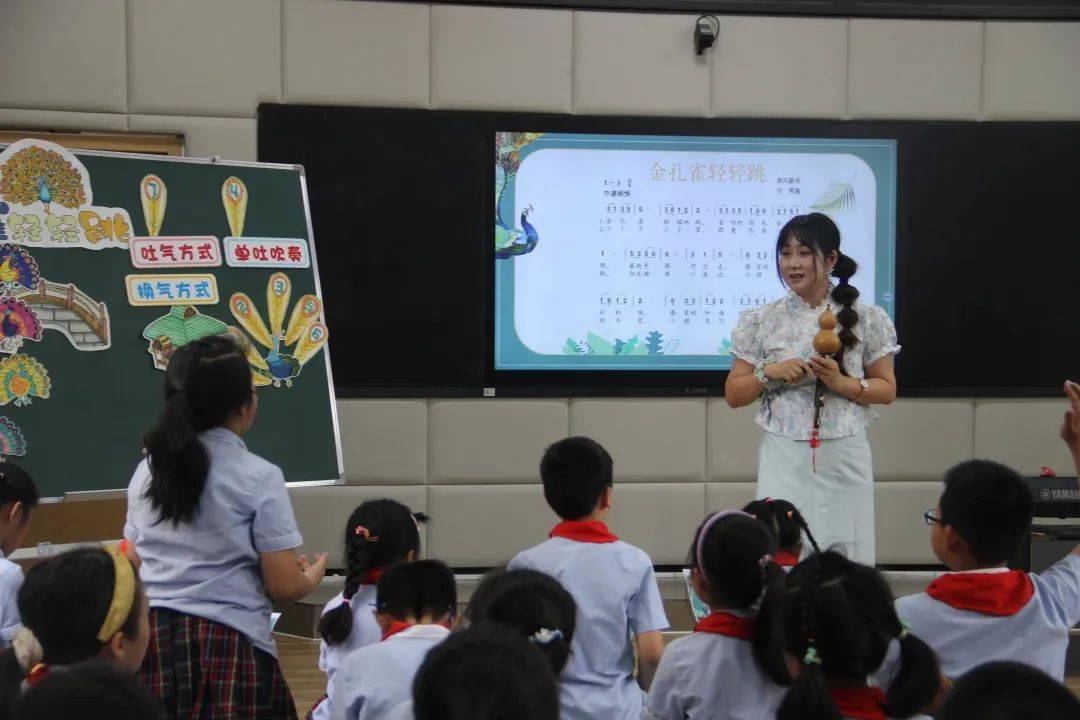Wenjiang District launches special teaching and research activities
The graceful sound of elegant clouds and smoke, the sound of sky and mountains and rivers. Under the policy of "Double Reduction", the warm summer wind is slow, the pace of teaching and research is fast, and in the colorful season, Mr. Ma Yue, a music teaching and researcher of Wenjiang District Research and Training Center, and music teachers from all over the district gathered in the East Second Foreign Language Experimental School to carry out "learning for the future". Under the concept of the center, the special teaching and research activity of “Research on the Implementation Strategy of Musical Instruments in Classrooms”.
Teacher Guo Ye kicked off the event with a special lecture on "Integrating Musical Instruments into Music Classes in Classroom", and shared the school's teaching work and development of cucurbit flute. Hulusi teaching is one of the characteristic courses of the school. Project research is carried out, and it enters into music classrooms and after-school services. The school carefully builds the education project of "one school, one characteristic, and one specialty in life", and conducts the cucurbit flute course in the teaching mode of performance. study.
In the appreciation class "Forest Rhapsody" taught by Mr. Tu Wenwen, the teacher created a scene, turned into a fairy in the forest, led the children into the wonderful forest kingdom, felt the music, experienced the music, and skillfully added the cucurbit flute to let the nature play. Authentic sounds are intertwined with beautiful instruments to play a wonderful forest song. At the same time, it guides students to feel, taste, and express music, which stimulates the students’ hearts to be good at discovering.
The "Golden Peacock Jumping Gently" taught by Principal Jiang, this class really brought "beauty" into the classroom, and taught through the processes of listening, guessing, singing, imitating, and acting, and led Jingwa into the classroom. Dai people, let them feel the beauty in the music class. In guiding the students to sing the songs confidently and naturally, the teacher added a beautiful and moving peacock dance, and incorporated the national musical instrument "Hulusi" into it. The Jingwas gradually learned from the shallower to the deeper, from the preliminary instrument playing - adjusting the timbre - mastering the difficulties of playing, etc., step by step, and in-depth learning of performance skills. While feeling the customs of the Dai people, they also experienced the beautiful dances and beautiful sounds of the Dai people. melody. You listen~~ Jingwas can be gentle and graceful, smooth and changeable, simple and elegant, vivid and beautiful, and majestic. Although the field of the class is broad, the playing of cucurbit flute is the most dazzling in this class. planet!

The teachers who attended the class were divided into several groups, and gave wonderful comments and high praises from three aspects: teaching design, teaching process, and teaching effect.
Teacher Ma Yue, a music teaching and researcher in Wenjiang District, commented on the two lessons from multiple angles and all aspects. Combined with the "determination of basic problems", "creation of real situations", "target setting", "pre-assessment and effectiveness", and "how to use the national musical instrument cucurbit flute in the classroom" in the teaching, a summary evaluation was made. , highly affirmed that the two classes can stand at the starting point of the new curriculum standard, and vividly display self-study, joint study, and group study in the classroom, and achieve a real "learning-centered"!
"Sound" means love, and "music" is in the classroom. Following the east wind of "double reduction", the East Second Foreign Language Experiment is constantly exploring the construction of efficient classrooms and harmonious classrooms to improve students' core literacy, and to develop together!
 渝公网安备 50010702504639号
渝公网安备 50010702504639号